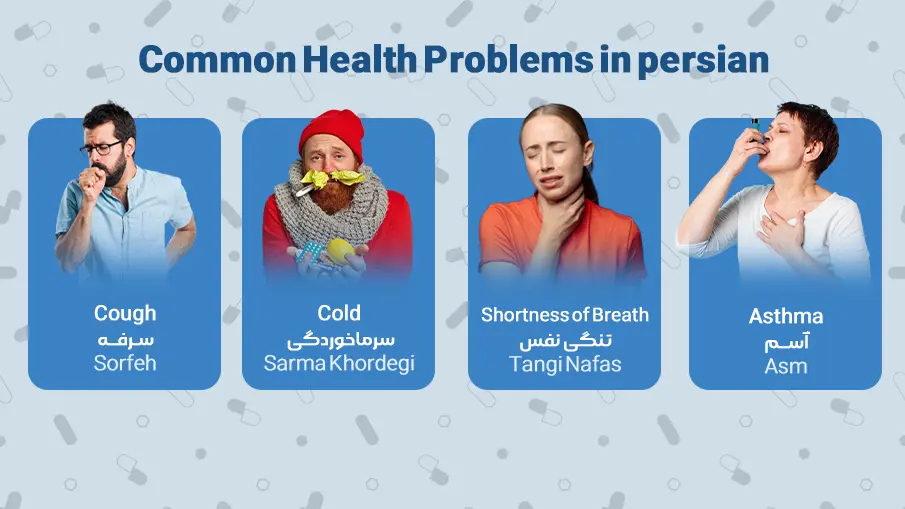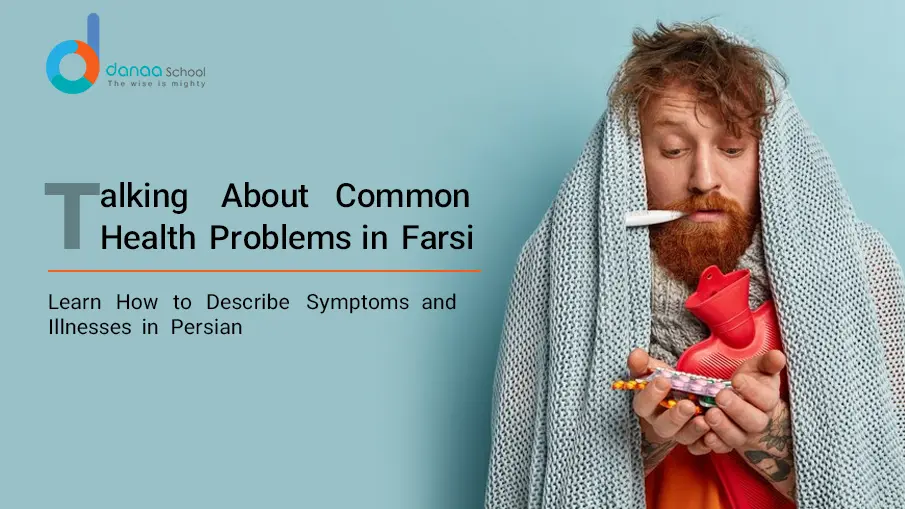Understanding how to discuss common health problems is essential when navigating medical conversations, especially when dealing with another language. Farsi, spoken predominantly in Iran, Afghanistan, and Tajikistan, is a key language to learn when visiting these regions. If you find yourself in a Persian-speaking environment, knowing basic medical terms in Farsi will help you communicate more effectively with healthcare providers.
This guide covers common health problems in Farsi and how to describe them. Whether you’re a language learner or a medical professional working with Persian-speaking patients, this article will improve your understanding of basic medical vocabulary in Farsi. We’ll cover everything from stomachaches to mental health, ensuring that you’re prepared to discuss a wide range of health concerns.
Common Health Problems in Farsi (Persian)
 Respiratory problems are among the most common health issues, and they can range from mild to severe. Knowing how to communicate these issues can save lives. Here are some common terms you might encounter:
Respiratory problems are among the most common health issues, and they can range from mild to severe. Knowing how to communicate these issues can save lives. Here are some common terms you might encounter:
-
- Cough – سرفه (Sorfeh)
-
- Cold – سرماخوردگی (Sarma Khordegi)
-
- Shortness of Breath – تنگی نفس (Tangi Nafas)
-
- Asthma – آسم (Asm)
Respiratory problems can escalate, especially in regions with high pollution levels. Being able to describe these symptoms helps doctors provide timely care.
Stomach and Digestive Problems in Farsi
Digestive problems are another common health issue. Whether it’s a mild upset stomach or severe abdominal pain, knowing how to describe your symptoms can assist in getting the right treatment. Key terms include:
-
- Stomach Pain – دلدرد (Deldard)
-
- Nausea – تهوع (Tahavvo)
-
- Indigestion – سوء هاضمه (Soo-ye Hazemeh)
-
- Diarrhea – اسهال (Eshaal)
Stomach issues can be caused by dietary habits, infections, or stress. If you’re ever traveling through Persian-speaking countries and eat something unfamiliar, these terms will be helpful to know.
Skin Conditions and Allergies in Farsi
Skin problems are often visible, but describing the discomfort they cause can be more difficult. Allergies and rashes are common conditions, particularly in areas with varied climates. Here’s how to describe some common skin conditions in Farsi:
-
- Rash – جوش (Joosh)
-
- Itching – خارش (Kharesh)
-
- Allergy – حساسیت (Hassasiyat)
-
- Eczema – اگزما (Ekzema)
Skin conditions can arise from a variety of causes, from allergens to infections. Properly communicating the severity of an allergic reaction is vital when seeking medical care.
Pain and Injuries in Farsi
Pain is a universal experience, but expressing its intensity and location is crucial in medical settings. Knowing how to describe pain will ensure that healthcare providers understand your condition:
-
- Pain – درد (Dard)
-
- Burn – سوختگی (Sookhtegi)
-
- Bruise – کبودی (Kaboodi)
-
- Fracture – شکستگی (Shekastegi)
Whether you’ve sprained your ankle or have a persistent headache, these terms will help bridge any language gap during a medical consultation.
Mental Health and Emotional Well-being in Farsi
Mental health is increasingly recognized as an essential aspect of overall well-being. Understanding how to talk about mental health issues in Farsi can break down barriers to receiving proper care. Some important terms include:
-
- Anxiety – اضطراب (Eztarāb)
-
- Depression – افسردگی (Afsordegi)
-
- Stress – استرس (Estress)
-
- Fatigue – خستگی (Khastagi)
With mental health becoming less stigmatized in Persian-speaking cultures, having these words in your vocabulary can help you or others seek the support needed.
Cardiovascular Problems in Farsi
Heart-related health issues are critical, and recognizing symptoms early can prevent life-threatening complications. Cardiovascular problems, including high blood pressure and heart disease, are some of the most pressing health concerns globally. Key terms include:
-
- High Blood Pressure – فشار خون بالا (Feshar Khun Bala)
-
- Heart Attack – حمله قلبی (Hamleh Ghalbi)
-
- Chest Pain – درد قفسه سینه (Dard Ghafaseh Sineh)
-
- Stroke – سکته مغزی (Sekteh Maghzi)
Understanding these terms can be particularly useful for older adults and individuals with a family history of heart disease.
Common Cold and Flu in Farsi
The cold and flu are regular occurrences in all parts of the world. Knowing how to explain these symptoms in Farsi will help you seek remedies, whether traditional or medicinal:
-
- Cold – سرماخوردگی (Sarma Khordegi)
-
- Flu – آنفولانزا (Anfluanza)
-
- Fever – تب (Tab)
-
- Sneezing – عطسه (Atseh)
As flu season approaches, these terms become essential for ensuring you can communicate your symptoms and seek appropriate treatment.
Diabetes and Blood Sugar Issues in Farsi
Diabetes is on the rise globally, and Iran is no exception. Being able to explain diabetic symptoms or understand instructions for managing blood sugar is crucial. Here are some useful terms:
-
- Diabetes – دیابت (Diabet)
-
- Blood Sugar – قند خون (Qand Khun)
-
- Insulin – انسولین (Insulin)
-
- Hypoglycemia – هیپوگلیسمی (Hypoglycemia)
Monitoring blood sugar levels and managing diabetes can be tricky, but knowing these Farsi terms makes it easier when talking to Persian-speaking doctors or pharmacists.
Headaches and Migraines in Farsi
Headaches, whether mild or severe, are something most people experience at some point. Being able to describe your pain accurately can lead to better diagnosis and treatment:
-
- Headache – سردرد (Sardard)
-
- Migraine – میگرن (Migren)
-
- Dizziness – سرگیجه (Sargijeh)
-
- Light Sensitivity – حساسیت به نور (Hassasiyat Be Noor)
Migraines can be debilitating, and discussing them in a foreign language might feel challenging. With these terms, however, it becomes a bit easier.
Learn Farsi with Danaa School
If you’re interested in learning Farsi in a practical and engaging way, Danaa School offers a comprehensive platform for mastering the Persian language. Whether you’re a beginner or looking to improve your existing skills, Danaa School provides interactive classes and resources to help you communicate effectively in various scenarios, including medical conversations. Start your Farsi journey today with Danaa School!
Find Your Ideal Teacher
At Danaa School, you can choose your Farsi tutor from a selection of qualified and experienced teachers. Begin an exceptional journey into the world of Persian language!
Book Your Trial Lesson
FAQs
How do I say "I have a fever" in Farsi?
“Man tab daram” (من تب دارم).
What is the word for "allergy" in Farsi?
“Hassasiyat” (حساسیت).
How do you say "high blood pressure" in Farsi?
“Feshar Khun Bala” (فشار خون بالا).
What is the Farsi word for "headache"?
“Sardard” (سردرد).
How do I describe shortness of breath in Farsi?
“Tangi Nafas” (تنگی نفس).
What is the term for "diabetes" in Farsi?
“Diabet” (دیابت).
Conclusion
Learning common health problems in Farsi is a powerful way to enhance your ability to communicate effectively in Persian-speaking regions. Whether you’re dealing with something as routine as a cold or managing a chronic illness, knowing the right words will give you confidence when speaking to healthcare professionals.
Building a foundation in medical Farsi will help you bridge cultural and language gaps, ensuring better understanding and improved health outcomes for yourself or those you care for. Start Learning Farsi now.
Want to Learn Farsi at Danaa School?
Here are the best resources for you!







